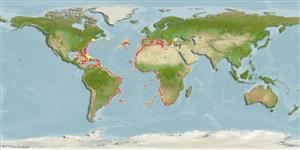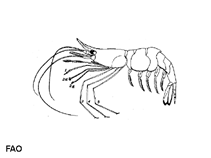Plesionika acanthonotus (Smith, 1882)
Lesser striped shrimp| Native range | All suitable habitat | Point map | Year 2050 |

|
| This map was computer-generated and has not yet been reviewed. |
| Plesionika acanthonotus AquaMaps Data sources: GBIF OBIS |
Classification / Names Common names | Synonyms | CoL | ITIS | WoRMS
| Decapoda | Pandalidae
Environment: milieu / climate zone / depth range / distribution range Ecología
; rango de profundidad 190 - 1550 m (Ref. 106425), usually 500 - 750 m (Ref. 106425). Subtropical; 45°N - 38°S, 89°W - 34°E
Distribución Países | Áreas FAO | Ecosistemas | Ocurrencias, apariciones | Introducciones
Atlantic Ocean and the Mediterranean: From Portugal to South Africa (West African waters from 16° to 28°S) and Straits of Florida to Turkey.
Length at first maturity / Tamaño / Peso / Age
Maturity: Lm ? range ? - ? cm Max length : 8.5 cm TL macho / no sexado; (Ref. 804)
Found on the middle continental slope (Ref. 105377). Non-migrator macrozooplankton feeder (Ref. 52384). Active predator of macroplankton species. Diet is based on smaller prey like siphonophores, hyperiids and euphausiids (Ref. 105341).
Life cycle and mating behavior Madurez | Reproducción | Puesta | Huevos | Fecundidad | Larva
Members of the order Decapoda are mostly gonochoric. Mating behavior: Precopulatory courtship ritual is common (through olfactory and tactile cues); usually indirect sperm transfer.
Main reference
Referencias | Coordinador | Colaboradores
Bianchi, G., K.E. Carpenter, J.-P. Roux, F.J. Molloy, D. Boyer and H.J. Boyer. 1999. (Ref. 804)
IUCN Red List Status (Ref. 130435)
CITES status (Ref. 108899)
Not Evaluated
CMS (Ref. 116361)
Not Evaluated
Threat to humans
Human uses
| FishSource |
Herramientas
Más información
Países
Áreas FAO
Ecosistemas
Ocurrencias, apariciones
Introducciones
Stocks
Ecología
Dieta
componentes alimenticios
Áreas FAO
Ecosistemas
Ocurrencias, apariciones
Introducciones
Stocks
Ecología
Dieta
componentes alimenticios
Fuentes de Internet
BHL | BOLD Systems | CISTI | DiscoverLife | FAO(Publication : search) | Fishipedia | GenBank (genome, nucleotide) | GloBI | Gomexsi | Google Books | Google Scholar | Google | PubMed | Árbol de la vida | Wikipedia (Go, búsqueda) | Expediente Zoológico
Estimates based on models
Preferred temperature
(Ref. 115969): 5.9 - 14.3, mean 13.5 (based on 76 cells).
Resiliencia
(Ref. 69278):
Alto, población duplicada en un tiempo mínimo inferior a 15 meses (K=0.5-0.55).



